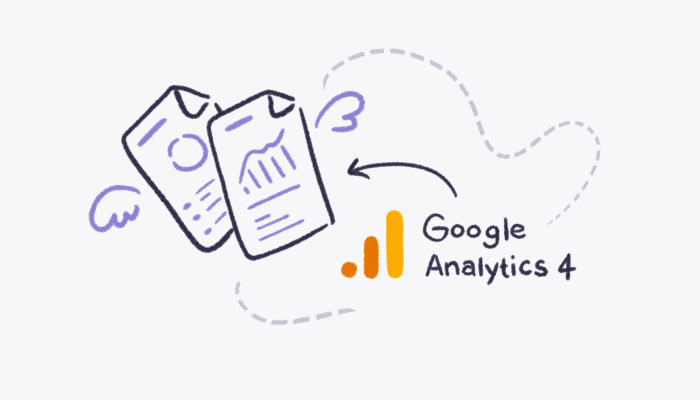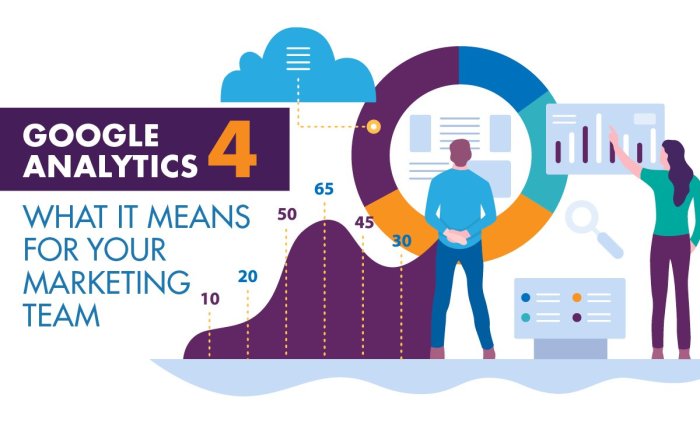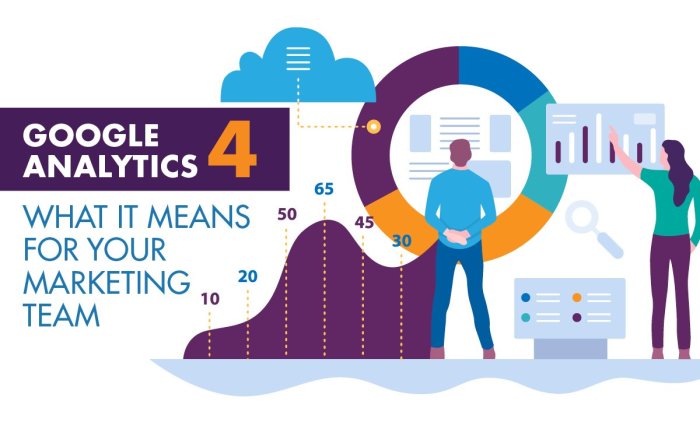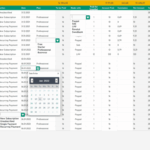Google Analytics reports to improve marketing are crucial for understanding website performance and optimizing your strategies. This deep dive explores how to leverage these reports to track key metrics, identify user behavior patterns, segment audiences, and ultimately boost conversions. We’ll uncover the secrets hidden within your website data and translate them into actionable marketing insights.
From understanding basic metrics like website traffic sources and bounce rates to analyzing complex conversion funnels and calculating return on investment (ROI), this guide will empower you to make data-driven decisions that significantly improve your marketing campaigns. We’ll cover everything from identifying your marketing goals and KPIs to creating compelling reports and dashboards that showcase your successes.
Understanding Google Analytics Reports

Google Analytics provides a wealth of data crucial for understanding website performance and optimizing marketing strategies. By meticulously analyzing these reports, marketers can gain insights into user behavior, identify areas for improvement, and ultimately drive better results. This detailed look at Google Analytics reports will help you navigate the platform and extract actionable intelligence.
Key Metrics in Google Analytics Reports
Understanding the various metrics within Google Analytics reports is essential for effective marketing analysis. These metrics provide quantifiable data on website traffic, user engagement, and conversion rates, offering valuable insights into campaign effectiveness and website performance. Metrics such as bounce rate, session duration, and pages per session paint a vivid picture of user behavior on your website.
Types of Google Analytics Reports
Google Analytics organizes data into various reports, each focusing on specific aspects of website performance. These reports, categorized as Audience, Acquisition, Behavior, and Conversions, provide a comprehensive view of your website’s performance, from user demographics to conversion pathways. Analyzing these reports allows you to make data-driven decisions for optimizing your marketing campaigns and achieving your business goals.
Audience Report
This report provides insights into your website visitors. It details demographic information, geographic locations, and other user characteristics, allowing you to tailor your marketing efforts to specific audience segments. Understanding your audience allows for targeted messaging and content optimization. For example, knowing your audience’s preferred devices (desktop, mobile, tablet) helps you tailor your website’s design and functionality.
| Metric Name | Description | Typical Value Range | Interpretation |
|---|---|---|---|
| Average Session Duration | Average time spent by users on your website during a session. | 15-60+ seconds | A longer average session duration usually indicates higher user engagement. |
| Bounce Rate | Percentage of sessions where users viewed only one page before leaving. | 25-75% | A high bounce rate might indicate issues with page content, navigation, or user experience. |
| New vs. Returning Visitors | Breakdown of new and returning visitors. | Varied based on site traffic | Understanding this ratio helps in optimizing strategies to retain returning customers and attract new ones. |
| Geographic Location | Breakdown of user locations visiting your site. | Global or regional | Identifies target markets and allows for tailored marketing strategies. |
Acquisition Report
This report details how users arrive at your website. Understanding the source of traffic (e.g., organic search, social media, paid advertising) is crucial for optimizing marketing channels. Tracking referral sources helps identify successful partnerships and content that attracts traffic.
Google Analytics reports are crucial for improving marketing strategies. Understanding user behavior through these reports helps identify what’s working and what isn’t. However, to truly optimize conversions, it’s essential to consider the psychological principles behind website design and user experience, such as psychological principles converting website. By combining data-driven insights from Analytics with a deep understanding of these principles, marketers can create more effective campaigns and ultimately achieve better results.
| Metric Name | Description | Typical Value Range | Interpretation |
|---|---|---|---|
| Source/Medium | Channels driving traffic to your site (e.g., Google, Facebook). | Organic, Social, Paid | Identifies high-performing channels for optimizing marketing budgets. |
| Traffic Channels | Breakdown of traffic sources. | Organic, Paid, Referral | Understanding traffic channels provides insight into where your website traffic is coming from. |
| Campaign Source | Tracking traffic from specific campaigns. | Specific campaign names | Helps measure campaign performance and ROI. |
Behavior Report
This report focuses on user behavior on your website. Understanding how users interact with your website’s content is crucial for improving user experience and engagement. Analyzing page views, time on page, and other behavioral metrics provides insight into website usability.
| Metric Name | Description | Typical Value Range | Interpretation |
|---|---|---|---|
| Pages/Session | Average number of pages viewed per session. | 1-10+ | Higher values usually indicate deeper engagement with your site. |
| Average Session Duration | Average time spent by users on your website during a session. | 15-60+ seconds | A longer average session duration usually indicates higher user engagement. |
| Exit Pages | Pages where users leave your website. | Varied based on site content | Helps in understanding user drop-off points and potential areas for improvement in content or navigation. |
Conversions Report
This report tracks the successful completion of desired actions on your website, such as purchases, sign-ups, or form submissions. Understanding conversion rates allows you to optimize your marketing strategies to drive more conversions.
| Metric Name | Description | Typical Value Range | Interpretation |
|---|---|---|---|
| Conversion Rate | Percentage of users who complete a desired action. | 0.5-50+% | Higher values usually indicate more effective marketing strategies. |
| Conversion Value | Monetary value of each conversion. | Varied based on conversion type | Useful for calculating ROI and evaluating the effectiveness of marketing campaigns. |
Identifying Marketing Goals and KPIs
Understanding your business objectives is crucial for crafting effective marketing strategies. Defining clear marketing goals, and then translating those goals into measurable Key Performance Indicators (KPIs), is the foundation for success. This process allows you to track progress, adjust tactics as needed, and ultimately demonstrate the return on investment (ROI) of your marketing efforts. This section details how to align website data with your marketing goals and provides examples of relevant KPIs.
Identifying Marketing Goals Based on Business Objectives
Your business objectives form the bedrock for your marketing goals. If your primary objective is to increase revenue, your marketing goals might focus on driving sales conversions. Conversely, if your aim is to expand brand recognition, your goals could center around increasing brand awareness. Aligning marketing goals with overarching business objectives ensures your marketing efforts contribute directly to achieving your larger business targets.
Linking Website Data to Marketing Goals
Website data provides valuable insights into how your marketing efforts are performing. By tracking website traffic, user behavior, and conversion rates, you can determine whether your campaigns are effectively reaching your target audience and achieving your defined goals. For example, if your goal is lead generation, you can track website forms submissions, email sign-ups, and other actions that signify potential customers engaging with your brand.
Examples of Key Performance Indicators (KPIs)
KPIs are quantifiable metrics used to track progress toward your marketing goals. Choosing the right KPIs depends entirely on the specific marketing objectives. For instance, if your objective is to boost brand awareness, impressions, reach, and engagement rate on social media might be suitable KPIs. If the goal is to improve customer acquisition, you might focus on website traffic, bounce rate, and conversion rates.
The KPIs you select should provide a clear picture of the success or failure of your marketing initiatives.
Marketing Goal and KPIs Comparison
| Marketing Goal | KPIs | Target Values |
|---|---|---|
| Brand Awareness | Website traffic, social media engagement (likes, shares, comments), brand mentions, reach, impressions | Increase website traffic by 15%, double social media engagement, and see a 10% increase in brand mentions. |
| Lead Generation | Website form submissions, email sign-ups, demo requests, contact inquiries | Increase form submissions by 20%, achieve a 10% increase in email sign-ups, and double the number of demo requests within the quarter. |
| Sales | Conversion rate, average order value, revenue, number of sales, customer lifetime value | Increase conversion rate by 5%, aim for a 10% increase in average order value, and see a 15% rise in overall revenue. |
Analyzing Website Traffic and User Behavior
Unraveling the secrets behind website traffic and user behavior is crucial for optimizing marketing strategies. Understanding where visitors are coming from, how they interact with your site, and why they might leave is vital for making informed decisions about your marketing efforts. By analyzing this data, you can identify patterns, pinpoint areas for improvement, and ultimately drive more conversions.Analyzing user behavior provides valuable insights into how your target audience interacts with your website.
This knowledge allows you to tailor your marketing campaigns to resonate more effectively with your audience, leading to increased engagement and conversions.
Analyzing Website Traffic Sources
Website traffic sources provide a roadmap to understand where your visitors are originating. Tracking the sources of your website traffic, such as organic search, paid advertising, and social media, is essential for understanding which channels are driving the most valuable traffic. This information enables you to optimize your marketing budget and focus resources on the most effective channels.
- Organic Search: Understanding the s driving traffic from search engines like Google is crucial for optimizing content and improving search engine rankings. This data reveals the terms users are searching for to find your website, helping you tailor content and improve strategies. Analyzing organic search traffic helps you understand which s are most effective in driving relevant traffic.
- Paid Advertising: Tracking paid advertising campaigns allows you to assess the effectiveness of your paid strategies, including which ad campaigns are performing best and which are underperforming. Data from paid advertising sources provides a clear picture of which s, ad copy, and targeting strategies are most successful in driving traffic and conversions.
- Social Media: Analyzing social media traffic allows you to identify which social platforms are most effective for driving traffic to your website. This insight allows for targeted social media campaigns and content creation that resonates with your audience, leading to higher engagement and conversions.
Comparing User Behavior Across Devices and Demographics
Understanding how users interact with your website across different devices (desktops, tablets, and mobile phones) and demographics (age, location, interests) is crucial for tailoring your website experience. Analyzing these differences helps you understand user preferences and needs, enabling you to optimize your site for maximum effectiveness across all user segments.
- Device Differences: Comparing user behavior on different devices reveals important insights into how users navigate your site and what features they find most useful. Analyzing the behavior of mobile users, for example, might reveal that certain pages load slowly on mobile devices, prompting a need to optimize the website’s mobile experience.
- Demographic Segmentation: Dividing your user base by demographic groups (e.g., age, location, interests) allows you to understand how different groups interact with your website. Analyzing these differences helps you tailor your marketing messaging and website content to resonate more effectively with each group, improving engagement and conversions.
Identifying User Engagement Metrics
Analyzing user engagement metrics like bounce rate and time on site is crucial for understanding how users interact with your website. Tracking these metrics allows you to identify areas where users are dropping off and understand the reasons behind their behavior. This knowledge enables you to improve website content, navigation, and design for better user experience.
- Bounce Rate: The percentage of visitors who leave your website after viewing only one page. A high bounce rate may indicate that your website’s landing page or content isn’t engaging enough, or that the user’s expectations weren’t met. It’s important to investigate the causes of high bounce rates and adjust your strategy accordingly.
- Time on Site: The average amount of time users spend on your website. A low time on site might indicate that your website’s content is not relevant to the user’s needs or that the navigation is confusing. Analyzing this metric helps you optimize the site for better user engagement.
Identifying Trends in User Behavior
Analyzing trends in user behavior reveals patterns that can inform your marketing strategies. By identifying these trends, you can make data-driven decisions to improve user experience, increase engagement, and achieve your marketing goals.
- Seasonal Trends: Identifying seasonal trends in user behavior allows you to anticipate changes in demand and adapt your marketing strategies accordingly. Understanding when users are most active and interested in your products can lead to optimized marketing campaigns.
- Day-of-Week Trends: Identifying day-of-week trends allows you to optimize content and marketing efforts for specific days when user activity is high. This knowledge helps you understand when your target audience is most active and receptive to your messaging.
Examples of User Behavior Insights
User behavior insights can directly inform marketing strategies by highlighting areas for improvement. For example, if data reveals a high bounce rate on a specific product page, you can investigate the reasons behind this and potentially redesign the page for better clarity, or modify the product description to align better with user expectations. This allows you to improve the overall user experience and drive higher conversion rates.
| User Behavior Metric | Significance | Example Values | Actions to Take |
|---|---|---|---|
| Bounce Rate | Percentage of visitors leaving after one page view | 50% (high), 20% (medium), 10% (low) | Optimize landing page content, improve navigation, ensure clear calls to action |
| Time on Site | Average time spent on the website | 1 minute (low), 5 minutes (medium), 10 minutes (high) | Enhance content quality, create more engaging content, improve site navigation |
| Traffic Source | Origin of website visitors (organic, paid, social) | Organic: 60%, Paid: 30%, Social: 10% | Optimize , refine paid campaigns, enhance social media presence |
| Device Usage | Usage of different devices (desktop, mobile, tablet) | Desktop: 40%, Mobile: 60% | Optimize website design for mobile, improve mobile experience |
Segmenting and Targeting Audiences
Understanding your website visitors isn’t just about counting page views; it’s about understanding
- who* those visitors are and
- what* they want. Segmenting your audience allows you to tailor your marketing efforts to specific groups, leading to more effective campaigns and higher conversion rates. By identifying common characteristics and behaviors, you can craft messages that resonate with each segment, boosting engagement and driving better results.
Segmenting your website visitors based on demographics, interests, and behavior is a crucial step in optimizing your marketing strategy. This process enables you to deliver targeted messages that speak directly to the needs and desires of specific groups, increasing the likelihood of conversions and maximizing the impact of your campaigns.
Methods for Segmenting Website Visitors
Identifying distinct visitor groups based on various criteria like demographics, interests, and behaviors is a cornerstone of effective marketing. By understanding these segments, you can craft tailored marketing messages that resonate with each group, boosting engagement and driving conversions.
- Demographics: Gathering data on visitor age, gender, location, and income levels allows you to create segments based on shared characteristics. This data helps you understand the profile of your audience, such as their likely needs, preferences, and motivations.
- Interests: Analyzing the pages visitors interact with, the products they view, and the content they engage with helps you understand their passions and preferences. Identifying common interests enables you to create segments focused on specific hobbies, products, or services, leading to more relevant marketing efforts.
- Behavior: Tracking visitor actions, such as their frequency of visits, time spent on site, and engagement with specific content, reveals patterns and tendencies. This behavioral data allows you to segment users based on their engagement levels, allowing you to target those who are most likely to convert.
Creating Custom Audience Segments
Custom segments are not just about pre-defined categories; they are about tailoring segments to match your specific marketing goals. Google Analytics allows for the creation of custom segments based on specific criteria, allowing for a high level of precision in targeting.
- Defining Criteria: Specify the criteria for your segment using various filters. These can include specific pages visited, events triggered, or specific timeframes. For instance, you might create a segment for users who have viewed a specific product page in the last week.
- Combining Filters: To create a more refined segment, combine multiple filters. This allows for more nuanced segmentation based on complex interactions. For example, you could combine a filter for users who viewed a product page with a filter for users who added that product to their cart.
- Naming Segments: Give your segments descriptive names that clearly indicate their characteristics, making it easy to identify and recall them. For example, a segment might be called “High-Value Prospects” or “Returning Customers.”
Tailoring Marketing Messages Based on Audience Segments
Once segments are defined, tailored marketing strategies can be developed for each group.
- Personalized Content: Use the data to tailor content that is more relevant to each segment. For example, a segment interested in hiking might receive content related to hiking gear or trail maps.
- Targeted Advertising: Run ads focused on the interests and needs of each segment. For example, ads targeting users who have previously purchased hiking boots might focus on new, upgraded hiking boots.
- Improved Engagement: Craft targeted messages and promotions that speak directly to the needs of each segment. This will likely result in higher engagement rates.
Segmentation Criteria and Benefits, Google analytics reports to improve marketing
| Segmentation Criteria | Key Characteristics | Recommended Marketing Approaches ||—|—|—|| Demographics (Age) | Users aged 18-25 | Focus on trendy products and social media marketing. || Interests (Hiking) | Users interested in hiking gear | Promote hiking equipment, trails, and related outdoor activities. || Behavior (Returning Visitors) | Users who have visited the site multiple times | Offer exclusive discounts, promotions, and personalized recommendations.
|
Optimizing Conversion Funnels
Understanding your conversion funnel is crucial for any successful online marketing strategy. It reveals the journey your website visitors take from initial interaction to desired action, allowing you to identify pain points and areas for improvement. By meticulously analyzing each stage, you can refine the user experience and boost conversion rates, leading to a more profitable online presence.
Analyzing Conversion Funnels
Conversion funnels are visualized as a series of steps a user takes on their journey to a conversion event. Understanding the funnel’s structure and the user’s path is vital to optimizing it. Analyzing each step helps identify areas where users drop off, enabling you to focus on these critical points. Tools like Google Analytics provide valuable data on user behavior at each stage, enabling targeted optimization efforts.
Steps in Optimizing Conversion Funnels
To effectively optimize your conversion funnel, follow these key steps:
- Identify the key conversion events: Clearly define the desired actions that constitute a successful conversion, such as completing a purchase, signing up for a newsletter, or requesting a quote. This sets a benchmark for success and allows for precise tracking.
- Map the user journey: Create a visual representation of the typical steps users take to convert. This could be a simple flowchart or a more detailed map, enabling you to understand the user experience at each stage.
- Analyze conversion rates at each stage: Utilize Google Analytics or similar tools to measure conversion rates at each stage of the funnel. Identify drop-off points where users are abandoning the process. High drop-off rates at specific stages highlight critical areas requiring attention.
- Identify bottlenecks in the process: Analyze the reasons behind user drop-offs. Are there technical issues, confusing navigation, or unclear calls to action? Pinpointing the cause is critical for targeted optimization.
- Improve user experience: Make necessary adjustments to improve the user experience at each stage. This could involve refining the design, streamlining the checkout process, or enhancing the clarity of calls to action. Prioritize the user experience over aesthetics and consider user feedback to drive improvement.
- Implement A/B testing: Test different versions of pages or elements to determine what performs best. A/B testing allows for iterative optimization of the user experience to maximize conversion rates.
Identifying Bottlenecks in the Conversion Process
Bottlenecks often appear as significant drops in conversion rates at specific stages of the funnel. These drops indicate potential issues that hinder the user’s journey.
- High bounce rates on specific pages: If a landing page has a significantly high bounce rate, it suggests that the page isn’t engaging users or providing the necessary information. The content, design, or calls to action on the page may be flawed.
- High drop-off rates during the checkout process: A large number of users abandoning the checkout process points to issues with the payment gateway, shipping options, or pricing transparency. Review and simplify the checkout process.
- Low click-through rates on key calls to action: If users are not clicking on essential calls to action, the language, design, or placement of the buttons may be suboptimal. Experiment with different styles to improve engagement.
Improving User Experience to Boost Conversions
Optimizing the user experience is a key driver of higher conversion rates. It involves understanding user needs and adapting the website to meet them effectively.
- Clear and concise calls to action: Use action-oriented language that guides users to the desired conversion event.
- Easy-to-navigate website: Streamline the navigation and ensure users can easily find the information they need.
- Mobile responsiveness: Ensure the website functions flawlessly across all devices, offering a seamless experience for mobile users.
- Fast loading times: Optimize website loading speed to prevent user frustration and ensure a positive experience.
Typical Conversion Funnel and Associated Metrics

| Stage of Conversion Funnel | Conversion Rate (%) | Optimization Suggestions |
|---|---|---|
| Awareness | 80% | Improve website visibility, enhance , create compelling content. |
| Interest | 60% | Create engaging content, highlight product benefits, and address user questions. |
| Desire | 40% | Showcase product features, highlight testimonials, and build trust through reviews. |
| Action | 20% | Simplify the checkout process, offer secure payment options, and provide clear shipping information. |
Measuring the ROI of Marketing Campaigns

Understanding the return on investment (ROI) of your marketing efforts is crucial for optimizing budgets and demonstrating the value of your strategies. This involves more than just tracking website traffic; it requires digging into the data to see how marketing initiatives translate into tangible results. Effective ROI measurement empowers data-driven decisions, allowing you to allocate resources effectively and maximize the impact of your campaigns.
Tracking Marketing Campaign Performance in Google Analytics
Google Analytics provides powerful tools for tracking campaign performance. Setting up campaign parameters in your marketing materials (URLs) allows you to meticulously monitor the sources driving traffic to your website. This granular level of tracking is essential for understanding which campaigns are resonating with your audience. You can also use UTM parameters to segment and analyze traffic from different marketing channels, such as social media, paid search, and email marketing.
This allows you to assess the effectiveness of each channel and allocate resources accordingly.
Calculating Return on Investment (ROI)
Calculating ROI involves comparing the revenue generated by a campaign to the cost of the campaign. A simple formula for ROI is:
(Revenue Generated – Campaign Costs) / Campaign Costs – 100%
Google Analytics reports are crucial for boosting marketing efforts. They reveal user behavior, showing where potential customers drop off in the sales funnel. Knowing this, implementing live chat, a powerful tool for immediate customer interaction, can significantly maximize conversions. How live chat can maximize conversions is a great resource for understanding this. Ultimately, these insights from analytics, combined with the efficiency of live chat, give you the data-driven strategies needed to truly optimize your marketing approach.
For example, if a campaign generated $5,000 in revenue and cost $1,000, the ROI would be ((5000-1000)/1000)*100% = 400%. This high ROI indicates the campaign was highly effective in generating revenue relative to its cost.
Google Analytics reports are invaluable for boosting marketing efforts. They reveal user behavior and website performance, helping you understand what’s working and what isn’t. However, focusing solely on maximizing revenue might miss the bigger picture, like building a lasting relationship with customers. Instead, consider the principles of value creation vs revenue extraction , and how your marketing strategies can deliver real value to your audience.
Ultimately, using data from these reports to refine your strategy, and focusing on providing value, will lead to better long-term marketing success.
Attributing Website Conversions to Specific Marketing Campaigns
Accurate conversion attribution is critical for measuring the ROI of each campaign. Google Analytics provides various attribution models to trace conversions back to their originating campaigns. These models include first-touch, last-touch, and linear models. Choosing the appropriate model depends on the specific marketing objectives and how conversions are typically influenced across channels.
Evaluating the Effectiveness of Different Marketing Channels
Different marketing channels contribute differently to overall campaign success. For example, social media marketing might drive significant brand awareness but may not always directly lead to immediate conversions. Analyzing data from each channel provides insights into their respective effectiveness. By understanding which channels perform best in generating conversions or engagement, you can refine your strategies and optimize your budget allocation across different channels.
Analyzing bounce rates, time on site, and pages per visit can also shed light on the effectiveness of your marketing efforts.
Using Data to Make Informed Decisions About Marketing Budgets
Analyzing campaign data enables informed decisions about future marketing budgets. If a particular campaign consistently demonstrates a high ROI, increasing its budget allocation could be a wise decision. Conversely, campaigns with low ROI may warrant budget reductions or strategy adjustments. By closely monitoring campaign performance and using data-driven insights, you can optimize your marketing spend and ensure maximum return.
Summarizing ROI Calculation
To calculate the ROI of a marketing campaign, you need to gather the following metrics:
- Revenue Generated: The total revenue directly attributable to the campaign.
- Campaign Costs: All expenses associated with the campaign, including advertising costs, staff time, and materials.
Applying the formula (Revenue Generated – Campaign Costs) / Campaign Costs
100% will provide the ROI percentage.
Reporting and Presenting Findings
Presenting your Google Analytics data effectively is crucial for showcasing the impact of your marketing efforts and gaining buy-in from stakeholders. Clear, concise, and visually compelling reports are key to driving action and achieving marketing objectives. A well-structured report should highlight key insights, trends, and opportunities gleaned from the data.A successful report goes beyond simply presenting raw data.
It should connect the dots between actions taken and the results achieved. This enables stakeholders to understand the value of the marketing initiatives and how they contribute to the overall business goals.
Creating Actionable Reports
To create reports that highlight key insights, start by defining specific objectives. What questions do you want to answer with the data? What are the key metrics that will demonstrate success? Focus on these metrics, rather than overwhelming stakeholders with a deluge of numbers. Prioritize clarity and conciseness.
Visualizing Key Insights
Visualizations are essential for conveying complex data in a digestible format. Charts and graphs effectively communicate trends, patterns, and anomalies. Use a variety of visualization techniques to cater to different learning styles.
Example Dashboard: Marketing Performance
This dashboard provides a high-level overview of key marketing metrics. It uses a combination of charts and tables to visually represent the data, making it easy for stakeholders to quickly grasp the performance trends.
Sample Dashboard Data
| Metric | Value | Visualization | Trend |
|---|---|---|---|
| Website Traffic (Unique Visitors) | 15,280 | Line chart showing monthly growth | Increasing |
| Conversion Rate | 3.5% | Bar chart comparing conversion rates across different channels | Stable |
| Bounce Rate | 42% | Bar chart showing bounce rates by landing page | Needs Improvement |
| Average Session Duration | 2 minutes 15 seconds | Line chart showing trend over time | Slight Decrease |
| Cost Per Acquisition (CPA) | $50 | Bar chart comparing CPA across different campaigns | Decreasing |
Note
* This is a sample dashboard. Adjust the metrics and visualizations based on your specific marketing objectives.
Effective Communication Strategies
Effective communication is crucial for conveying insights to stakeholders. Use clear and concise language, avoid jargon, and tailor your message to their understanding. Highlight key findings and their implications.
Present your findings in a clear and concise manner. Avoid overwhelming stakeholders with excessive data.
Focus on the insights and their practical implications. Use storytelling to connect data points to business goals and demonstrate the impact of marketing efforts.
Conclusion: Google Analytics Reports To Improve Marketing
In conclusion, mastering Google Analytics reports is essential for any marketer looking to achieve optimal results. By understanding the data, identifying trends, and tailoring your strategies accordingly, you can unlock the full potential of your online presence. This guide has provided a comprehensive overview, enabling you to confidently leverage the power of Google Analytics to drive your marketing efforts forward.






